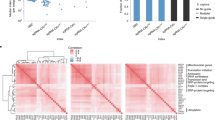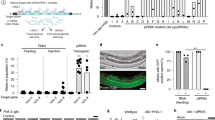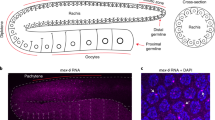Abstract
RNA interference (RNAi) is an evolutionarily conserved defence mechanism whereby genes are specifically silenced through degradation of messenger RNAs; this process is mediated by homologous double-stranded (ds)RNA molecules1,2,3,4. In invertebrates, long dsRNAs have been used for genome-wide screens and have provided insights into gene functions5,6,7,8. Because long dsRNA triggers a nonspecific interferon response in many vertebrates, short interfering (si)RNA or short hairpin (sh)RNAs must be used for these organisms to ensure specific gene silencing9,10,11. Here we report the generation of a genome-scale library of endoribonuclease-prepared short interfering (esi)RNAs12 from a sequence-verified complementary DNA collection representing 15,497 human genes. We used 5,305 esiRNAs from this library to screen for genes required for cell division in HeLa cells. Using a primary high-throughput cell viability screen followed by a secondary high content videomicroscopy assay, we identified 37 genes required for cell division. These include several splicing factors for which knockdown generates mitotic spindle defects. In addition, a putative nuclear-export terminator was found to speed up cell proliferation and mitotic progression after knockdown. Thus, our study uncovers new aspects of cell division and establishes esiRNA as a versatile approach for genomic RNAi screens in mammalian cells.
This is a preview of subscription content, access via your institution
Access options
Subscribe to this journal
Receive 51 print issues and online access
$199.00 per year
only $3.90 per issue
Buy this article
- Purchase on Springer Link
- Instant access to full article PDF
Prices may be subject to local taxes which are calculated during checkout




Similar content being viewed by others
References
Fire, A. et al. Potent and specific genetic interference by double-stranded RNA in Caenorhabditis elegans. Nature 391, 806–811 (1998)
Bernstein, E., Caudy, A. A., Hammond, S. M. & Hannon, G. J. Role for a bidentate ribonuclease in the initiation step of RNA interference. Nature 409, 363–366 (2001)
Elbashir, S. M., Lendeckel, W. & Tuschl, T. RNA interference is mediated by 21- and 22-nucleotide RNAs. Genes Dev. 15, 188–200 (2001)
Martinez, J., Patkaniowska, A., Urlaub, H., Luhrmann, R. & Tuschl, T. Single-stranded antisense siRNAs guide target RNA cleavage in RNAi. Cell 110, 563–574 (2002)
Gonczy, P. et al. Functional genomic analysis of cell division in C. elegans using RNAi of genes on chromosome III. Nature 408, 331–336 (2000)
Fraser, A. G. et al. Functional genomic analysis of C. elegans chromosome I by systematic RNA interference. Nature 408, 325–330 (2000)
Kamath, R. S. et al. Systematic functional analysis of the Caenorhabditis elegans genome using RNAi. Nature 421, 231–237 (2003)
Boutros, M. et al. Genome-wide RNAi analysis of growth and viability in Drosophila cells. Science 303, 832–835 (2004)
Elbashir, S. M. et al. Duplexes of 21-nucleotide RNAs mediate RNA interference in cultured mammalian cells. Nature 411, 494–498 (2001)
Paddison, P. J., Caudy, A. A., Bernstein, E., Hannon, G. J. & Conklin, D. S. Short hairpin RNAs (shRNAs) induce sequence-specific silencing in mammalian cells. Genes Dev. 16, 948–958 (2002)
Brummelkamp, T. R., Bernards, R. & Agami, R. A system for stable expression of short interfering RNAs in mammalian cells. Science 296, 550–553 (2002)
Yang, D. et al. Short RNA duplexes produced by hydrolysis with Escherichia coli RNase III mediate effective RNA interference in mammalian cells. Proc. Natl Acad. Sci. USA 99, 9942–9947 (2002)
Zheng, L. et al. An approach to genomewide screens of expressed small interfering RNAs in mammalian cells. Proc. Natl Acad. Sci. USA 101, 135–140 (2004)
Berns, K. et al. A large-scale RNAi screen in human cells identifies new components of the p53 pathway. Nature 428, 431–437 (2004)
Paddison, P. J. et al. A resource for large-scale RNA-interference-based screens in mammals. Nature 428, 427–431 (2004)
Calegari, F., Haubensak, W., Yang, D., Huttner, W. B. & Buchholz, F. Tissue-specific RNA interference in postimplantation mouse embryos with endoribonuclease-prepared short interfering RNA. Proc. Natl Acad. Sci. USA 99, 14236–14240 (2002)
Kronke, J. et al. Alternative approaches for efficient inhibition of hepatitis C virus RNA replication by small interfering RNAs. J. Virol. 78, 3436–3446 (2004)
Henschel, A., Buchholz, F. & Habermann, B. DEQOR: a web-based tool for the design and quality control of siRNAs. Nucleic Acids Res. 32, W113–W120 (2004)
Liebel, U., Kindler, B. & Pepperkok, R. ‘Harvester’: a fast meta search engine of human protein resources. Bioinformatics 20, 1962–1963 (2004)
Blangy, A. et al. Phosphorylation by p34cdc2 regulates spindle association of human Eg5, a kinesin-related motor essential for bipolar spindle formation in vivo. Cell 83, 1159–1169 (1995)
Harborth, J., Elbashir, S. M., Bechert, K., Tuschl, T. & Weber, K. Identification of essential genes in cultured mammalian cells using small interfering RNAs. J. Cell Sci. 114, 4557–4565 (2001)
Weis, K. Regulating access to the genome: nucleocytoplasmic transport throughout the cell cycle. Cell 112, 441–451 (2003)
Biggins, S., Bhalla, N., Chang, A., Smith, D. L. & Murray, A. W. Genes involved in sister chromatid separation and segregation in the budding yeast Saccharomyces cerevisiae. Genetics 159, 453–470 (2001)
Burns, C. G. et al. Removal of a single alpha-tubulin gene intron suppresses cell cycle arrest `phenotypes of splicing factor mutations in Saccharomyces cerevisiae. Mol. Cell. Biol. 22, 801–815 (2002)
Prasanth, K. V., Sacco-Bubulya, P. A., Prasanth, S. G. & Spector, D. L. Sequential entry of components of the gene expression machinery into daughter nuclei. Mol. Biol. Cell 14, 1043–1057 (2003)
Gruss, O. J. et al. Chromosome-induced microtubule assembly mediated by TPX2 is required for spindle formation in HeLa cells. Nature Cell Biol. 4, 871–879 (2002)
Makarov, E. M. et al. Small nuclear ribonucleoprotein remodeling during catalytic activation of the spliceosome. Science 298, 2205–2208 (2002)
Sherr, C. J. & Roberts, J. M. Inhibitors of mammalian G1 cyclin-dependent kinases. Genes Dev. 9, 1149–1163 (1995)
Dorsett, Y. & Tuschl, T. siRNAs: applications in functional genomics and potential as therapeutics. Nature Rev. Drug Discov. 3, 318–329 (2004)
Jackson, A. L. et al. Expression profiling reveals off-target gene regulation by RNAi. Nature Biotechnol. 21, 635–637 (2003)
Acknowledgements
We thank F. Stewart, I. Baines, T. Hyman and M. Slabicki for critical reading and comments on the manuscript. We thank K. Weis for helpful discussions. We are grateful to M. Boutros for providing protein accession numbers and sequences of the cell viability screen in Drosophila cells. This study was supported by the Max Planck Society and by the EU-FP6 grant Mitocheck. L.P. is supported by a postdoctoral fellowship from the HFSP.
Author information
Authors and Affiliations
Corresponding author
Ethics declarations
Competing interests
The authors declare that they have no competing financial interests.
Supplementary information
Supplementary Information
Supplementary Data, Supplementary Methods, Supplementary Tables 1–3, Supplementary Figure Legends 1–4 and references. (DOC 72 kb)
Supplementary Figure 1
Mitotic indices for 29 genes identified to cause a mitotic arrest. (PDF 349 kb)
Supplementary Figure 2
Nuclear localization and domain structure of KIAA1387. (JPG 169 kb)
Supplementary Figure 3
Effect on cell viability of 26 esiRNAs targeting genes encoding ribosomal proteins. (PDF 287 kb)
Supplementary Figure 4
Sequence analysis of RPS4Y and RPS4X. (PDF 101 kb)
Rights and permissions
About this article
Cite this article
Kittler, R., Putz, G., Pelletier, L. et al. An endoribonuclease-prepared siRNA screen in human cells identifies genes essential for cell division. Nature 432, 1036–1040 (2004). https://doi.org/10.1038/nature03159
Received:
Accepted:
Issue Date:
DOI: https://doi.org/10.1038/nature03159
This article is cited by
-
Protective effect and mechanism research of Phyllanthus emblica Linn. fruit extract on UV-induced photodamage in keratinocytes
Photochemical & Photobiological Sciences (2023)
-
Loss of USP28 and SPINT2 expression promotes cancer cell survival after whole genome doubling
Cellular Oncology (2022)
-
Secreted midbody remnants are a class of extracellular vesicles molecularly distinct from exosomes and microparticles
Communications Biology (2021)
-
PacBio single molecule long-read sequencing provides insight into the complexity and diversity of the Pinctada fucata martensii transcriptome
BMC Genomics (2020)
-
A high-content RNAi screen reveals multiple roles for long noncoding RNAs in cell division
Nature Communications (2020)
Comments
By submitting a comment you agree to abide by our Terms and Community Guidelines. If you find something abusive or that does not comply with our terms or guidelines please flag it as inappropriate.



